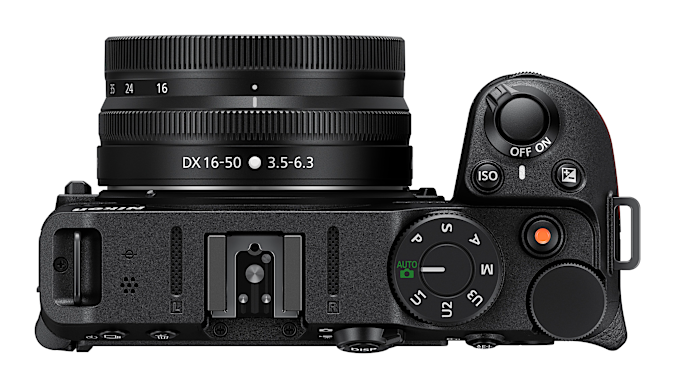Nikon has unveiled the 20.9-megapixel APS-C Z30, its smallest and lightest Z-series camera yet. Designed for vloggers and creators, it offers a flip-out display, 4K 30p video and a long 125-minute video record time when plugged in — but lacks an electronic viewfinder.
The Z30 is Nikon’s third APS-C (DX) mirrorless camera so far, after the Z50 and Z fc models. It uses the same giant Z-mount as the company’s full-frame models, which effectively dominates the relatively small body. It has a simple but effective control setup with a mode dial on top, front and rear dials to set exposure, a photo/video selector switch, and buttons for ISO, exposure compensation, AF-lock and shooting mode. A new feature over the other DX models is a tally light on front so vloggers can see when they’re recording.
Nikon
The hand grip is deep for such a small camera, but due to the large mount, there’s not a ton of room between the lens for your fingers. As mentioned, it has a fully-articulating 3.0-inch screen that activates self-portrait mode when flipped out, letting you set key controls like exposure compensation with the camera at at arm’s length. Other key features include built-in stereo mics, a microphone input and a single UHS-I SD memory card slot. Unfortunately, it lacks a headphone jack which is a negative for video creators.
The Z30 competes with Sony’s ZV-E10 vlogging camera and has one advantage over its rival. It can shoot 4K at up to 30fps using the full width of the sensor, where Sony’s model has a 1.23x crop at 30fps. That’s fairly important for vlogging, as a crop makes it harder to get yourself into the shot. It can also shoot 1080p at up to 120 fps for slow-mo, but unlike the ZV-E10, doesn’t support log capture — only a “flat” profile. Like its Sony rival, the Z30 has no built-in IBS — only electronic stabilization.
[embedded content]
Nikon promises reliably fast and sharp hybrid phase-detect autofocus with face, eye and animal AI detection. It’s likely similar to the AF on the Z50 and Z fc models, which are decent but lag behind Sony’s APS-C cameras in terms of AF speed and accuracy. It offers a picture control auto function depending on the scene, along with 20 creative profiles. However, there’s no one-click “product showcase” or bokeh options like Sony offers on the ZV-E10.
It has a relatively small battery (the same on the other two DX models) giving it a 330 shot CIPA rating. Unlike the Z50 and Z fc which were limited to 30 minutes, the Z30 can record up to 125 minutes of 1080p video and about 35 minutes of 4K. To get those figures, though, you’ll have to plug the camera’s USB-C port to power.

Nikon
Nikon promises good photography performance as well, but it’s already behind the 8-ball in that area without an electronic viewfinder. Still, you get shooting speeds up to 11 fps (mechanical shutter, JPEG/RAW), hybrid phase-detect AF and even the ability to shoot a photo while recording video.
The Z30 arrives in mid-July at $710 for the body only, $850 with a kit Nikkor Z DX 16-50mm f/3.5-6.3 lens, or $1,200 with the Nikkor Z DX 50-250mm f/4.5-6.3 lens. Another option coming in November is the 14-140mm f/3.5-6.3 lens for $1,150. Nikon will also offer a Creators Accessory Kit for $150 with a SmallRig tripod grip, Nikon ML-L7 Bluetooth remote and a Rode VideoMicro microphone.
Along with the camera, Nikon also unveiled a new full-frame Z-mount lens, the Z400mm f/4.5 VR S. Nikon says it’s the lightest lens in its class at 2.55 pounds, offers dust- and drip-resistant performance and a focus-breathing compensation function for video recording. It arrives in July 2022 for $3,250.
All products recommended by Engadget are selected by our editorial team, independent of our parent company. Some of our stories include affiliate links. If you buy something through one of these links, we may earn an affiliate commission.

